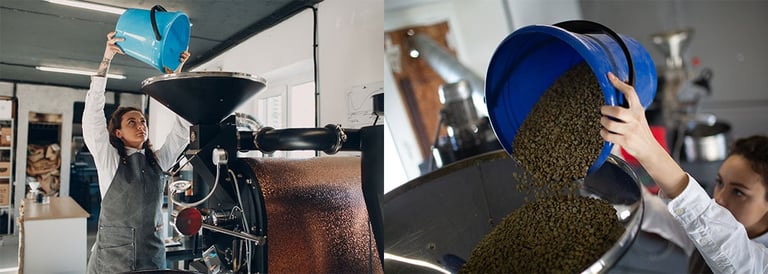怪我の危険性を排除するには

食品生産ラインはリスクの高いラインです。作業員は繰り返し作業を行うことが多く、機械への送り込み、製品の積み込みや包装など、多くの手作業が必要とされます。
手作業は、怪我のリスク増加に密接に関係してきます。無理な体勢、繰り返し作業の増加、強い力が必要な状況を避けることが極めて重要です。搬送物の搬送をオートメーション化することで、作業時の怪我リスクを大幅に減らし、エルゴノミックな労働環境が実現します。
人間工学(エルゴノミック)は食品業界において特に重要です。米国の統計によると、食品加工作業では休業日発生率(LWDI)が全業界の中で最も高く、3.3の業界のスタンダードと比較し、怪我と病気の発生率が正規労働者100人あたり6.5人となっています。
生産ラインにおける人間工学的な課題
きつい作業を繰り返し長時間続けると、筋肉や腱、靭帯、神経、血管に慢性的な損傷を負うことになります。これは労働関連筋骨格系障害(WMSD)と呼ばれます。蓄積性外傷疾患(CTD)および反復運動過多損傷(RSD)は食品工場に勤務する作業員の間でよく見られます。
重いものを持ち上げたり、引っ張ったり、押したりすることで、筋肉に負担がかかり、無理な姿勢で作業をすることで体のさまざまな部分で捻挫や歪みが起こります。たとえば、ミキサーに投入するために袋を持ち上げたり、包装作業時に物品を取ろうとして手足を伸ばしたりすることで、必然的に怪我のリスクが上がります。さらに、肉体労働の場合は疲労がたまりやすく、労働災害の一般的な原因となっています。
しかし、ほとんどの怪我は微小外傷によるものです。小さな傷がいくつも重なることで組織にダメージを与えていくのです。疾患は、腱鞘炎(腱の炎症)、手根管症候群(手首の正中神経の腫れと巻き込み)、胸郭出口症候群(首と肩の間の神経と血管の圧迫)、坐骨神経痛(腰の椎間板が膨らんだり破れたりして、腰の痛みが足にも及ぶ)として現れます。
痛みから得るものは何もありません
作業に起因する怪我の症例は、動作や圧迫、寒さや振動などによる痛みや、関節の可動域の減少などさまざまです。また、手足や指のしびれや違和感、握力の低下、関節の腫れなどの症状が出ることもあります。しかし、こういった症状が発生するのには何週間、何か月、何年もかかることがあり、多くの場合、初期段階では無症状です。そのため、不可逆的損傷がすでに発生しているときに傷害が診断されることが多々あります。
作業員が受ける肉体的、心理的、経済的苦痛とは別に、雇用主にとっては、傷害は確実に作業員の病欠、賠償請求、離職などに繋がり、費用が増加します。しかし、決して無視できないものであるにも関わらず、傷害に関連する費用が生産コスト全体の計算に含まれることは滅多にありません。確実に変化が必要です。
オートメーション化により生産性を向上する
傷害を確実に避けるためには、きつく繰り返しの多い肉体労働をオートメーション化する必要があります。オートメーション化できる作業は多く存在します。特に粉体の搬送においては、粉体のピックアップから機器間の搬送、そして包装まで可能です。
バキュームコンベアによる搬送作業は、作業員の手作業が減るだけでなく、衛生的でシンプルなソリューションです。作業員は袋やドラム缶に吸引パイプを入れることで、粉体を密閉性の高い搬送ライン送り、次工程の機器に供給することができるようになります。小麦粉や砂糖、添加物、スパイス、コーヒー豆など、流動性のある物であれば搬送が可能です。搬送先の機器は、ミキサーやブレンダーなど、様々です。
生産ラインのオートメーション化で要求されるレベルに対応するソリューションです。投入ホッパーなどの供給ポイントを導入することで、より快適でエルゴノミックな労働環境を作ることができます。この場合、オペレーターの作業は搬送物が入った袋を開けて、投入ホッパーに移すだけです。あとはバキュームコンベアが粉体を搬送してくれます。階段を上ったり、フォークリフトを使ってミキサーやブレンダーなどの機器の上部まで重たい袋を運ぶ必要がなくなります。
フィードパイプやノズルを使って袋やバーレルから粉体を直接搬送することもできます。この供給プロセス中、オペレーターは移動する必要がありません。
食品生産ラインには多くの作業工程がありますが、手作業による材料搬送をPiabのバキュームコンベアで自動化すれば、作業員が筋骨格系疾患を発症するリスクを低減できます。生産ラインの機器間をしっかり接続することで密閉性の高い搬送システムを構築できます。これは、生産性にも大きく影響してきます。
混合機の他、粉砕機や挽き機にもバキュームコンベアで搬送できます。キャンディーやチューインガムといった完成済みの製品や傷つきやすい繊細な製品を包装工程に運ぶ場面においても、Piabのバキュームコンベアとアクセサリーを組み合わせることで、完成品を搬送することが可能です。
他にも、打錠機やスティック包装機、その他の包装機械など、バキュームコンベアを接続できる機器は多くあります。
コーヒーの場合は、材料のピックアップから豆の製粉、粉砕、焙煎、そして包装に至るまでのプロセス全体をオートメーション化することも可能です。プロセス全体には、挽いたコーヒーや傷んだ豆を回収する廃棄物処理の手順も含まれています。
製パン会社であるドイツのAusterschmidt社は、Piabのバキュームコンベアを導入して種の搬送をオートメーション化しました。これまでは従業員がシャベルを使用して散布装置のホッパーへ種を供給していました。
ポーランドのPolmlek Raciaz社はPiabのバキュームコンベアを利用して、インスタントミルク顆粒を搬送しています。両社ともオートメーション化により製品の品質に関する問題を解決しました。また、プロセスを管理するのに必要なマンパワーを削減できたこともメリットでした。
ポーランドのメーカーCronberg社は、ペットフードを製造しています。Piabのバキュームコンベアをプロセスに導入することで、同社の従業員は、地上8メートルの高さまで袋物を運搬してミキサーに供給する必要がなくなりました。